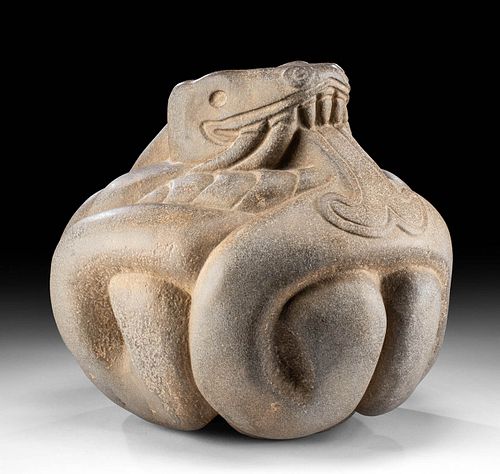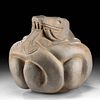Impressive Aztec Stone Coiled Snake - Quetzalcoatl
Lot 220
About Seller
Artemis Gallery
686 S Taylor Ave, Ste 106
Louisville, CO 80027
United States
Selling antiquities, ancient and ethnographic art online since 1993, Artemis Gallery specializes in Classical Antiquities (Egyptian, Greek, Roman, Near Eastern), Asian, Pre-Columbian, African / Tribal / Oceanographic art. Our extensive inventory includes pottery, stone, metal, wood, glass and textil...Read more
Estimate:
$30,000 - $40,000
Absentee vs Live bid
Two ways to bid:
- Leave a max absentee bid and the platform will bid on your behalf up to your maximum bid during the live auction.
- Bid live during the auction and your bids will be submitted real-time to the auctioneer.
Bid Increments
| Price | Bid Increment |
|---|---|
| $0 | $25 |
| $300 | $50 |
| $1,000 | $100 |
| $2,000 | $250 |
| $5,000 | $500 |
| $10,000 | $1,000 |
| $20,000 | $2,500 |
| $50,000 | $5,000 |
| $100,000 | $10,000 |
| $200,000 | $20,000 |
About Auction
By Artemis Gallery
Oct 7, 2021
Set Reminder
2021-10-07 10:00:00
2021-10-07 10:00:00
America/New_York
Bidsquare
Bidsquare : Exceptional Antiquities Ethnographic Fine Art
https://www.bidsquare.com/auctions/artemis-gallery/exceptional-antiquities-ethnographic-fine-art-7537
Museum-worthy examples of Egyptian, Greek, Roman, Etruscan, Near Eastern, Far East / Asian, Pre-Columbian, African / Tribal, Oceanic, Native American, Spanish Colonial, Fossils, Ancient Jewelry, Fine / Visual Arts, so much more! Artemis Gallery info@artemisgallery.com
Museum-worthy examples of Egyptian, Greek, Roman, Etruscan, Near Eastern, Far East / Asian, Pre-Columbian, African / Tribal, Oceanic, Native American, Spanish Colonial, Fossils, Ancient Jewelry, Fine / Visual Arts, so much more! Artemis Gallery info@artemisgallery.com
- Lot Description
Pre-Columbian, Central Mexico, Aztec, ca. 1325 to 1475 CE. An expertly carved and quite large volcanic stone sculpture depicting a coiled Quetzalcoatl, the mythical serpent, with an intimidating visage presenting incised beady eyes, an open mouth revealing sharp fangs and a long, forked tongue that extends down to the lower coil of its body, and a lengthy rattler as its tail. The body itself is smoothly carved with overlapping coils as though tied into a mesmerizing knot. Snakes provide a fascinating element of Pre-Columbian iconography, as important symbols of power, rebirth, transition, and renewal. Since snakes shed their skin annually, thus rejuvenating themselves, the ancients of Mexico viewed them as providing hope for the possibility of change in the face of adversity. Size: 11.5" L x 10.1" W x 10.5" H (29.2 cm x 25.7 cm x 26.7 cm)
A pair of Aztec stone serpents can be found at the Metropolitan Museum of Art, 1 nearly identical under accession number 1979.206.477 and the other with its mouth closed under accession number 00.5.32. The curator's description of 00.5.32 points to other serpents depicted in ancient Mexican visual culture, "At the Main Temple in the Aztec imperial capital Tenochtitlan, serpent depictions proliferate: monumental snake heads, probably representing different species - with open fanged mouths and forked tongues - flank braziers and stairways leading to the sanctuaries. The temple itself is said to have been surrounded at the time of the Spanish conquest by a serpent wall, or Coatepantli, formed by hundreds of adjoining sculptures of snakes."
This serpent form represents Quetzalcoatl - "Feathered Serpent" in the Nahuatl language - the Pre-Columbian deity revered as lord of wind and sky. The earliest representations of Quetzalcoatl adorn the Temple of Quetzalcoatl in Teotihuacan, Mexico (ca. 3rd century CE) where numerous stone heads of the divine plumed snake embellish the steps of this Pre-Classic pyramid. The pioneering artist/anthropologist Miguel Covarrubias whose writings and illustrations on indigenous cultures of the ancient Americas continue to contribute to scholarly studies today stated, "Quetzalcoatl stood for all that was good in this world: peace, art, wisdom, and prosperity. Disguised as an ant, he discovered maize, the staple food of the Indians, hidden under the mountain of Substance, Tonacatepetl; he also invented the arts, the sciences, and the calendar. In fact, everything connected with wisdom and culture was attributed to Quetzalcoatl." (Miguel Covarrubias, Mexico South: The Isthmus of Tehuantepec (New York: Alfred A. Knopf, 1946), 130)
Cf. The Vilcek Foundation, accession number 2003.01.1
An Aztec stone serpent of matching size and form was sold for $60,000 by Sotheby's New York during their African, Oceanic and Pre-Columbian Art auction on May 17th, 2007 (sale number N08320, lot 240).
This piece has been searched against the Art Loss Register database and has been cleared. The Art Loss Register maintains the world's largest database of stolen art, collectibles, and antiques.
Provenance: private Santa Fe collection, Santa Fe, New Mexico, USA, acquired 2003; ex-Ron Messick Fine Arts, Santa Fe, New Mexico, USA, 2003; ex-Allen Davis collection, Chardon, Ohio, USA
All items legal to buy/sell under U.S. Statute covering cultural patrimony Code 2600, CHAPTER 14, and are guaranteed to be as described or your money back.
A Certificate of Authenticity will accompany all winning bids.
PLEASE NOTE: Due to recent increases of shipments being seized by Australian & German customs (even for items with pre-UNESCO provenance), we will no longer ship most antiquities and ancient Chinese art to Australia & Germany. For categories of items that are acceptable to ship to Australia or Germany, please contact us directly or work with your local customs brokerage firm.
Display stands not described as included/custom in the item description are for photography purposes only and will not be included with the item upon shipping.
#167906Miniscule nick on side of head, as well as a few light abrasions in areas. Otherwise, intact and excellent with remarkable preservation of detail and smoothly carved surfaces.Condition
- Shipping Info
-
All shipping is handled in-house for your convenience. Your invoice from Artemis Gallery will include shipping calculation instructions. If in doubt, please inquire BEFORE bidding for estimated shipping costs for individual items.
-
- Buyer's Premium



 EUR
EUR CAD
CAD AUD
AUD GBP
GBP MXN
MXN HKD
HKD CNY
CNY MYR
MYR SEK
SEK SGD
SGD CHF
CHF THB
THB















